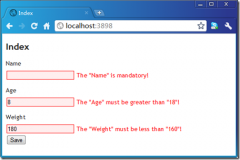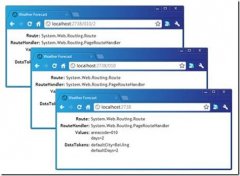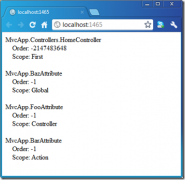MVC缓存02,使用数据层缓存,添加或修改时让缓存失效
在"MVC缓存01,运用控制器缓存或数据层缓存"中,在数据层中可以设置缓存的有用时刻。但这个还不够"智能",常常期望在修改或创立的时分使缓存失效,加载新的数据。
□ 思路
1、缓存是以键值

2、EF上下文保留的时分时分把改变保留到数据库,并更新缓存中的内容。
● 先找出上下文中状况为added或modified的实体:var changeobjects
● 把改变保留数据到数据库:context.SaveChanges()
● 依据缓存key获取类型为IDictionary
● 最终遍历这些改变的实体,更新缓存项:cacheData[vehicle.Id] = vehicle;
□ 缓存接口
public interface ICacheProvider
{
object Get(string key);
void Set(string key, object data, int cacheTime);
bool IsSet(string key);
void Invalidate(string key);
}
□ 缓存接口完成
环绕using System.Runtime.Caching的MemoryCache.Default回来类型为ObjectCache的缓存特点完成缓存接口:获取缓存项、设置缓存、判别是不是设置缓存、清空缓存。
using System;
using System.Runtime.Caching;
namespace MvcApplication1.Cache
{
public class DefaultCacheProvider : ICacheProvider
{
private ObjectCache Cache
{
get { return MemoryCache.Default; }
}
public object Get(string key)
{
return Cache[key];
}
public void Set(string key, object data, int cacheTime)
{
CacheItemPolicy policy = new CacheItemPolicy();
policy.AbsoluteExpiration = DateTime.Now + TimeSpan.FromMinutes(cacheTime);
Cache.Add(new CacheItem(key, data), policy);
}
public bool IsSet(string key)
{
return (Cache[key] != null);
}
public void Invalidate(string key)
{
Cache.Remove(key);
}
}
}
□ Model
public partial class Vehicle
{
public int Id { get; set; }
public string Name { get; set; }
public decimal Price { get; set; }
}
□ 对于Vehicle的Repositoy接口:
using System.Collections.Generic;
using MvcApplication1.Models;
namespace MvcApplication1.Repository
{
public interface IVehicleRepository
{
void ClearCache();
IEnumerableGetVehicles();
void Insert(Vehicle vehicle);
void Update(Vehicle vehicle);
void SaveChanges();
}
}
□ 对于Vehicle的Repositoy接口完成:
using System.Collections.Generic;
using System.Data;
using System.Data.Entity.Infrastructure;
using System.Linq;
using MvcApplication1.Cache;
using MvcApplication1.Models;
namespace MvcApplication1.Repository
{
public class VehicleRepository : IVehicleRepository
{
protected DemoEntities DataContext { get; private set; }
public ICacheProvider Cache { get; set; }
public VehicleRepository() : this(new DefaultCacheProvider())
{
}
public VehicleRepository(ICacheProvider cacheProvider)
{
this.DataContext = new DemoEntities();
this.Cache = cacheProvider;
}
public void ClearCache()
{
Cache.Invalidate("vehicles");
}
public System.Collections.Generic.IEnumerable GetVehicles()
{
var vehicles = Cache.Get("vehicles") as IDictionary<int, Vehicle>;
if (vehicles == null)
{
vehicles = DataContext.Vehicle.ToDictionary(v => v.Id);
if (vehicles.Any())
{
Cache.Set("vehicles",vehicles,30);
}
}
return vehicles.Values;
}
public void Update(Vehicle vehicle)
{
if (vehicle != null)
{
DataContext.Set().Attach(vehicle);
DataContext.Entry(vehicle).State = EntityState.Modified;
}
}
public void Insert(Vehicle vehicle)
{
DataContext.Set().Add(vehicle);
}
public void SaveChanges()
{
//获取上下文中EntityState状况为added或modified的Vehicle
var changeobjects = DataContext.ChangeTracker.Entries();
//把改变保留到数据库
DataContext.SaveChanges();
//更新缓存中有关的Vehicle
var cacheData = Cache.Get("vehicles") as Dictionary<int, Vehicle>;
if (cacheData != null)
{
foreach (var item in changeobjects)
{
var vehicle = item.Entity as Vehicle;
cacheData[vehicle.Id] = vehicle;
}
}
}
}
}
在保留缓存Cache.Set("vehicles",vehicles,30)之前,把从上下文获取到的数据转换成IDictionary
□ HomeController
using System.Linq;
using System.Web;
using System.Web.Mvc;
using MvcApplication1.Models;
using MvcApplication1.Repository;
namespace MvcApplication1.Controllers
{
public class HomeController : Controller
{
public IVehicleRepository Repository { get; set; }
public HomeController(IVehicleRepository repository)
{
this.Repository = repository;
}
public HomeController() : this(new VehicleRepository())
{
}
public ActionResult Index()
{
return View(Repository.GetVehicles());
}
[HttpPost]
public ActionResult Index(FormCollection form)
{
Repository.ClearCache();
return RedirectToAction("Index");
}
public ActionResult Edit(int id)
{
var vehicle = Repository.GetVehicles().Single(v => v.Id == id);
return View(vehicle);
}
[HttpPost]
public ActionResult Edit(Vehicle vehicle)
{
Repository.Update(vehicle);
Repository.SaveChanges();
return RedirectToAction("Index");
}
public ActionResult Create()
{
return View(new Vehicle());
}
[HttpPost]
public ActionResult Create(Vehicle vehicle)
{
Repository.Insert(vehicle);
Repository.SaveChanges();
return RedirectToAction("Index");
}
}
}
□ Home/Index.cshtml
@model IEnumerable
@{
ViewBag.Title = "Index";
Layout = "~/Views/Shared/_Layout.cshtml";
}
"0" cellspacing="0" border="0">
@foreach (var vehicle in Model)
{
}
| 编号 | 车型 | 报价 | |
|---|---|---|---|
| @vehicle.Id.ToString() | @vehicle.Name | @string.Format("{0:c}",vehicle.Price) |
@Html.ActionLink("修改", "Edit", new { id=vehicle.Id })
|
@using (Html.BeginForm())
{
"submit" value="使缓存失效从头获取数据库数据" id="InvalidButton" name="InvalidButton"/>
}
@Html.ActionLink("创立", "Create")
□ Home/Create.cshtml
Create
@using (Html.BeginForm()) { @Html.ValidationSummary(true)Vehiclevalue="Create" />
} @section Scripts { @Scripts.Render("~/bundles/jqueryval") }
□ Home/Edit.cshtml
Edit
@using (Html.BeginForm()) { @Html.ValidationSummary(true)Vehicle@Html.HiddenFor(model => model.Id)value="Save" />
} @section Scripts { @Scripts.Render("~/bundles/jqueryval") }
□ 成果:
创立或修改之前: 
修改更新: 
创立: 
修改创立成功后: 
ASP.NET MVC基于标注特性的Model验证:Data
ASP.NET MVC5 网站开发实践(二) Member区域
认识ASP.NET MVC的5种AuthorizationFilter
ASP.NET MVC的Model元数据与Model模板:预
ASP.NET MVC三个重要的描述对象:ActionDes
热门源码

![MVC、MVP以及Model2[上篇]](http://p1.codesocang.com/uploads/allimg/c140311/139450911Z30P-143T_lit.png)







